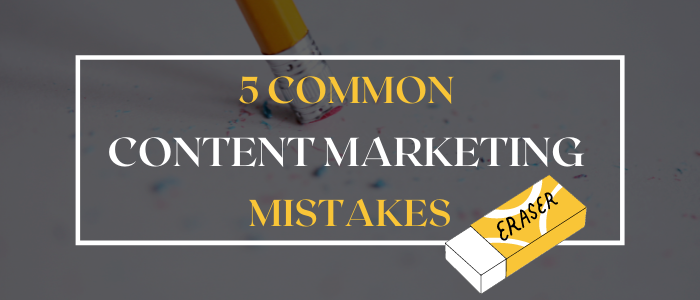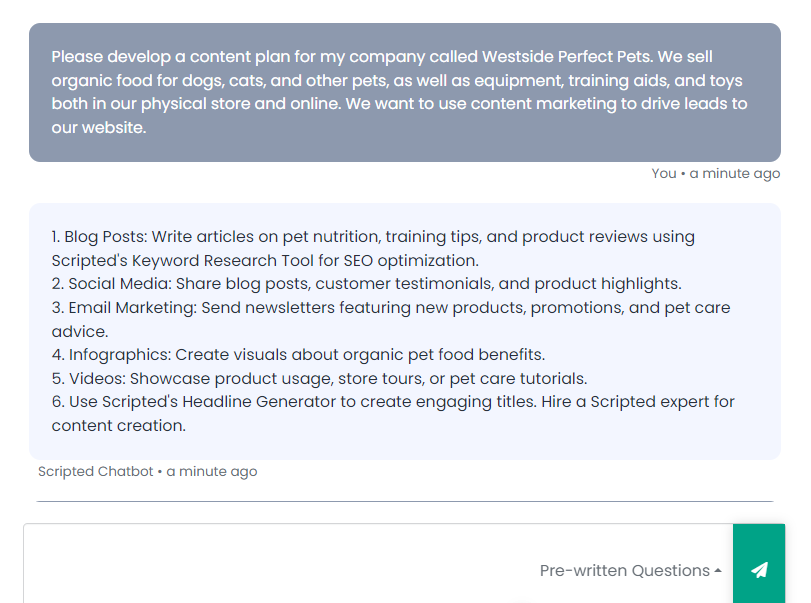- Blog Home
- Content Marketing
- Ciara Antolini
- 5 Common Content Marketing Mistakes
5 Common Content Marketing Mistakes

If you want your business discovered in a crowded, competitive online marketplace, content marketing is essential. Without it, your business won't have a chance. According to a recent HubSpot study, at least 70% of content marketers actively invest in their content marketing efforts, and around 25% of marketers plan to increase their investment in content marketing in the coming years.
Content marketing is a strategic approach focusing on sharing valuable content to attract a defined target audience and drive conversions and profit. Written content can include blog posts, long-form articles, white papers, ebooks, and social media posts, among other types. Videos, webinars, and audio content, such as podcasts, can also play a significant role in content marketing, depending on the company and the target audience.
There's a reason marketers focus on content marketing. When a content strategy is well-developed and search engine optimized (SEO), it becomes a powerhouse traffic driver to a business's website — it grows audiences. In fact, SEO content drives 1,000% more traffic to a site than organic social media.
However, even experienced content marketers can make mistakes.
One of the best ways to ensure your content strategy is doing well is to be aware of five common content marketing mistakes. So, keep reading to learn how and why mistakes happen — and the repercussions — and what you can do instead on your path to content marketing success.
1. Focusing on Quantity Instead of Quality

It might seem counterintuitive, but the amount of content you produce and publish is far less important than the quality of the content. It's tempting to fill your blog and social media channels with mediocre stuff as often as possible.
Your content doesn't need to win awards, though it should be of very high quality. It must solve the problems or pain points your target audience is experiencing. If the content doesn't provide what they need, they won't read or share it. Be sure your content is informative, engaging, and relevant.
What Is Low-Quality Content?
Content that misses the mark can include a variety of problems, and not all are obvious. Here are some common signs of low-quality content:
- Grammar and spelling errors or typos: Error-filled content is difficult to read and reduces a business's credibility.
- Factual errors: Inaccuracies and misleading statements can damage trust. If the content isn't carefully researched and fact-checked, it reflects on the company's products or services.
- Poorly written or unorganized format: Careless, wordy writing that's repetitive and needs more focus makes readers lose interest quickly. Disorganized formatting, such as inconsistent subheadings, lists, and image sizes, is also problematic.
- "Fluffy" content: This type includes long, wordy sentences and descriptions that add little to the main points. Fluffy content isn't informative or helpful, and it lacks substance.
- Plagiarized content: Plagiarism refers to content copied directly from the source without attribution. Even if a few words are changed, plagiarism can be noticeable when mixed with a different original writing style. Plus, readers may recognize the original author's words.
- Promotional content: Too much promotional content vs. informational content is annoying, at best. Content presented as information with a too-obvious sales agenda undermines trust.
- Clickbait: The sole purpose of clickbait content is to attract attention and clicks. It may be misleading, sensationalized, or exaggerated, so it doesn't earn respect or trust.
- Inconsistent content: One piece may be high-quality, but errors and inconsistencies litter the next. Format, style, and voice may also differ. Muddled brand identity and content are confusing for readers.
How Can You Avoid Low-quality Content?
High-quality content delivered less often generates anticipation and prevents content from getting lost in the online information onslaught. Consistently crafting high-quality content is part of a solid marketing strategy. Here's how:
- Know your target audience: What are their needs and interests? What problems are they trying to solve? What kinds of content do they consume? When you understand your audience, you can create content that's relevant and valuable to them.
- Research carefully: Before writing, consult authoritative sources to ensure your content is accurate. Researching the latest keeps you up-to-date and provides fascinating new angles for your topic.
- Write clearly and concisely: Content should be easy to read and understand. Avoid excessive slang, buzzwords, jargon, and technical terms your audience may not know. Use short paragraphs, headings, and subheadings to organize the information.
- Edit and proofread carefully: Before publishing, check carefully for errors in grammar, spelling, and punctuation. Ideally, an experienced editor and proofreader should review it.
- Promote your content. Nobody will read a high-quality piece of content if you don't promote it. Share it on social media, and include it in email newsletters.
PRO TIP: Catchy headlines for blog posts are a must if you want to stand out from the competition. You could spend hours brainstorming and still feel like it's not quite right. Why not try our free Headline Generator? Just type in a topic like "how to raise a puppy" or "how much to save for retirement" and click "Get Headlines." Within seconds, you'll get ten great possibilities. Edit or tweak a couple you like, or use them as they are. Want more ideas? Try it again.
Remember, you're better off with infrequent, high-value content than rolling out a daily deluge of hit-or-miss pieces. Quality content builds respect and trust and helps you achieve your marketing goals.
2. No Marketing Strategy or Content Plan

Imagine planning your first trip around Europe. You have only three weeks to visit old castles and Roman ruins in ten countries. It's 1990, and GPS has yet to be widely available. Would you plan and choose your route carefully? Pack a map? Or would you wing it?
Without a plan and a map, you won't get far, and too many things can go wrong. The same applies to content marketing.
A content strategy is like a blueprint or map that defines your approach to content marketing. It outlines your goals, target audience, and the type of content you'll focus on. A strategy also includes content distribution channels, such as social media and email.
A content plan is part of your content strategy. Also known as an editorial or content calendar, it helps you stay on task and evaluate progress. It also aids in managing the content production and publishing process: the what, when, and where of content marketing.
What Happens Without a Marketing Strategy or Content Plan?
Without a clear travel plan, you'll get delayed and discouraged. You won't get to the castle in Germany if you're out of gas in rural Italy. The same thing happens without a marketing strategy.
You need detailed plans for the types of content you'll produce and who creates it. What are the standards, and how will they be achieved or communicated? What's a reasonable time frame? Your content marketing will be disorganized and inconsistent without a strategy. Plus, it might not be aligned with your goals or your target audience's needs. Even if you create high-quality content, each piece alone won't grow your business. You need a strategy and a plan.
Here's what can happen if you don't have a good content marketing strategy:
- Lack of brand awareness: Without regularly published, high-quality content, potential leads and customers may not be aware of you.
- Fewer leads and sales: Without brand awareness, a business can't exist. By creating and distributing valuable content, companies can attract leads and customers and nurture them through the buyer's journey.
- Low trust and credibility: High-quality content builds trust with potential customers. Without a solid strategy, your credibility will be questionable.
- Not respected as a thought leader: Thought leadership means you're an industry expert, and people look up to you. Content marketing provides a way to share your knowledge and experience, but success requires a sensible strategy,
- Struggle to keep up with the competition: Many businesses use content marketing to achieve their business goals. Keeping up with the competition may be impossible without a well-planned strategy.
- Waste time and resources: Creating content misaligned with your business goals or target audience can lead to ineffective content marketing efforts and a lack of results.
- Failure to track results: Without analyzing content marketing metrics, it's challenging to know what's working and what's not, improve strategy, and make informed decisions.
How to Turn Lemons Into Lemonade
Do any of these examples sound familiar, or do you just want to avoid mistakes? Here are some content strategy examples that can work in your favor:
- SEO content strategy: Your target audience must be able to find your content with keyword searches. This content strategy focuses on creating and optimizing content to rank higher in SERPs (search engine results pages). SEO best practices attract visitors to your website and generate more leads and sales.
- Social media content strategy: Share your content regularly on social media platforms to build brand awareness, engage with your audience, and drive traffic to your website.
- Thought leadership content strategy: Build trust with your target audience and attract leads and customers with high-quality content that establishes you as an expert in your industry.
- Product marketing content strategy: Create and distribute valuable, informative content that helps potential customers find solutions to their problems. Positioning your products or services as solutions increases sales and generates leads.
- Customer relationship management (CRM): This strategy helps distribute content that builds and maintains relationships with your customers. Done well, it increases customer loyalty and satisfaction and reduces churn.
PRO TIP: One way to develop a content plan is to use Scripted's GPT-4 powered content strategy expert, Scripted Copilot. Using pre-written questions, you'll have a content plan and a content calendar you use right away! 
Here's what to do: Select the pre-written question. Develop a content plan for [company/website/industry]. Add your information to replace "company/website/industry" and other details. Click on "Pre-written questions" for content calendar options,
Start your free trial to see what Scripted Copilot can do!
No matter what your business goals are, a well-crafted content strategy and plan saves time and money in the long run. Creating high-quality content regularly and promoting it on the right channels means new leads and customers to grow your business.
3. Relying on Outdated SEO Practices

SEO (search engine optimization) is essential to creating content that builds your business. If your content isn't optimized, your target audience won't find it when searching for needed information. It will simply exist and take up space instead of working to build your brand.
But here's the mistake many people make: learning SEO and using the same thing they learned over and over again. SEO constantly evolves, and Google frequently updates algorithms. That means the "right" way to optimize your content can change quickly. Staying abreast of SEO updates ensures you know the current best practices for your content. You're not relying on techniques that worked a month, a year, or five years ago.
By avoiding outdated SEO practices, you can be confident your audience will find your content, and you won't lose potential business. Don't risk your content getting overlooked because you created it using old, irrelevant guidelines.
What Are Some Outdated SEO Practices?
Here are just a few of the most common SEO practices that won't do you any favors:
- Keyword stuffing: Using keywords as often as possible in your content means low-quality writing and challenging reading. Keyword stuffing is an old-fashioned black hat SEO practice that Google penalizes.
- Overusing keyword variations: Similar to keyword stuffing, overusing keyword variations can create low-quality content. Good writing generally avoids repetition, but intentionally stuffing an article with potential search terms, including misspelled terms, raises bounce rates and lowers ranking (e.g., running shoes, running footwear, athletic shoes, and runnign shoes),
- Link building through paid links or link directories: Google quickly identifies and devalues paid backlinks. Penalties can mean your content ranking sinks to the bottom of the barrel.
- Cloaking: This involves showing human visitors content that's different from what search engines find. Cloaking is an SEO technique that can get your website removed from Google search results.
What SEO Practices Does Google Penalize?
If a company or content marketer follows these outdated SEO practices, they could face the following repercussions:
- Degrading rank: Lower rank in search engine results pages (SERPs) that lead to less traffic.
- Deindexation: If Google deindexes your website, it won't appear in SERPs, which means a complete loss of organic traffic.
- Reputation damage: Many readers won't recognize black hat SEO tactics, but low-quality content doesn't inspire trust. And it won't attract new leads, customers, or potential partners.
Here Are Some Tips for Following SEO Best Practices
Adopting ethical, white-hat SEO practices and staying current with changes isn't complicated. In fact, it's easier.
- Create high-quality, relevant content.
- Use keywords naturally in your blog posts and website content.
- Build links from high-quality websites relevant to your target audience.
- Optimize your website for search engines, but avoid black hat practices.
- Be patient with your SEO efforts. Ethical SEO takes time, but it's worth it.
PRO TIP: Although SEO best practices are constantly changing, and keyword stuffing has always been a bad idea, you still need to use the right keywords so potential readers can find your content.
Scripted's AI Keyword Research Tool helps you optimize your content strategy with keyword idea generation. The Keyword Research Tool identifies relevant, effective keywords for content marketing. By analyzing search trends and other data, the tool suggests keywords likely to generate the most traffic and conversions. Using keywords naturally in your content helps optimize content for search engines and improve search engine visibility.
4. Not Defining Your Audience

In the good old days, many marketers and bloggers believed, "If you build it, they will come." Just create a website, write some snappy blog posts, and BAM. You're in business.
Today, everyone (hopefully) knows that doesn't work. Still, even with the best SEO, you have to get your content in front of people through social media, email marketing, and paid advertising.
Write a quick post or email, add a link, and BAM. Done.
If you're a magician, that might work. But for the rest of us, if you don't know who your target audience is, you might be better off renting a plane and dropping printed ads all over New York City on a windy day.
Your content can't reach potential customers without targeting a specific audience. You need to get familiar with their needs and interests. What problems — what pain points — are they trying to solve? What kind of content do they consume? What are their favorite social media platforms?
Not identifying a target audience is a common mistake. But if you want your content to earn more leads and improve sales, you need to be specific.
What Happens if You Don't Have a Target Audience?
Failing to identify a target audience can lead to the following problems:
- Creating irrelevant content: Without a clear target audience, the content might not be relevant to the needs and interests of people who view it. That can lead to low engagement and poor results.
- Wasting time and resources: Measuring the effectiveness of content marketing efforts is difficult without a clear target audience in mind.
- Failing to increase engagement and sales: Without knowing where and when your target audience spends their time online, a company may fail to reach them.
- Struggling to be unique: Businesses must differentiate themselves from the competition. You can set yourself apart by creating content customized to your target audience's specific needs and interests.
- Missing valuable feedback: Low target-audience interest can mean little feedback to improve content quality and better serve customers' needs.
Defining your target audience is an essential part of your content marketing strategy. Businesses can create more compelling content that reaches the right people and achieves their marketing goals.
How Do You Define a Target Audience?
Define your target audience with these tips:
- Discover pain points: What are the needs, challenges, or problems of people most likely to buy your product or service? If you sell sports equipment, for example, who's most likely to buy it?
- Look to existing customers: Analyze your existing customer base. If you have existing customers, evaluate their demographics, interests, and needs. What do they have in common, or what problems are they trying to solve?
- Research competitors: Who are your competitors targeting, and what kind of content are they creating? What marketing channels are they using? Understanding your competitors' target audience helps you differentiate yourself and reach new customers.
- Conduct surveys and interviews: Ask potential customers directly to learn more about your target audience. Understanding their needs, interests, and pain points helps you create content and marketing strategies tailored to their specific needs.
- Use social media analytics: Social media platforms, including X (Twitter), LinkedIn, and Facebook, offer a wealth of data about their users. You can use this data to learn more about your target audience's demographics, interests, and behaviors.
When you have a good understanding of your target audience, you can start to develop a content marketing strategy tailored to their specific needs.
Suggested Reading: Reaching the Senior Audience
5. Overlooking the Importance of Content Promotion

Once you've created great content, you need to promote it so people can find it. By sharing your content on social media and emailing it to your subscribers, you create opportunities for engagement with your target audience, which can lead to social sharing, backlinks, and word-of-mouth advertising.
But if you don't promote your content and rely only on website SEO, you're missing chances to improve your website's visibility and increase traffic, leads, and sales.
Lack of Content Promotion Problems
Lack of content promotion can lead to problems, including:
- Reduced brand awareness: Content marketing increases brand awareness. If you create but don't promote high-quality content, you'll miss opportunities to build trust with potential customers and grow your reputation as a thought leader in your industry.
- Fewer leads and sales: Ideally, content marketing generates leads and sales. But if you're not attracting potential customers with content promotion and nurturing them through the buyer journey, it can't convert more leads into customers.
- Loss of traffic and engagement: Content promotion drives traffic to your website and increases engagement with your brand. If you're not promoting your content, you'll miss out.
- Reduced SEO rankings: Content promotion contributes to SEO indirectly by driving traffic to your site. High-quality content means time spent on the site, a positive signal to search engines. However, without promotion, you're missing out on the SEO boost.
- Difficulty competing with other businesses: It's hard to keep up with competitors doing what you're not doing: promoting your content.
Content Promotion Ideas
Here are some ways to promote your content:
- Share it on social media.
- Email it to your subscribers.
- Submit it to relevant directories
- Use paid advertising.
- Guest blog on other websites.
- Attend industry events and conferences.
- Ask influencers to share your content.
The best ways to promote your content varies depending on your target audience and industry. But by using a variety of promotion channels, you can expand your reach so more people can engage with your content.
PRO TIP: Scripted is big on both AI tools and human writers. One area where AI shines is when you need quick, templated content. That includes social media posts. Promoting your content on social media increases brand visibility and engagement across multiple platforms. You don't need to say much for content promotion, but you want it done right.
Why not try our AI-powered Social Media Post Generator? Along with your content marketing strategy and plan, you can create social media posts in batches. With Scripted's Starter Plan, it's completely free. Just sign up for an account and let our Social Media Post Generator get to work! You can use all our free AI tools to save time, money, and resources on your templated content.
Don't waste time and money on AI prompt engineering or hiring for an expensive new role. Take advantage of our easy-to-use, customizable AI tools combined with the power of experienced writers. You can stay ahead of the competition if you get started right now.
Leverage Scripted AI and Human Content for Content Marketing
Whether you're a business owner or marketer, a top-notch content marketing strategy holds the key to lead generation, conversion, and sales. Content marketing doesn't produce results as fast as well-designed paid ads can. It takes a little longer. But the advantage of useful content like blog posts is they have staying power. PPC (pay-per-click) ads and other forms of paid advertising stop producing leads when you stop paying for them. But high-quality content lasts forever.
Need help with your content strategy? Scripted is the only platform that empowers users to switch effortlessly between AI-generated content and content crafted by human experts. Scripted eliminates the need for multiple platforms by providing a single, comprehensive solution that caters to both AI-generated and human-written content. Experience a new level of content marketing with Scripted — where AI meets human expertise, efficiency meets impact, and your content goals become reality.
Get started with a free 30-day trial or schedule a short video call with a Scripted Content Strategist.

Published by Ciara Antolini on Monday, October 30, 2023 in Content Marketing, Content, Content Marketing, Content Strategy.